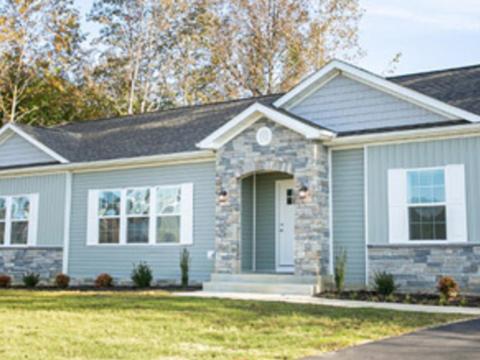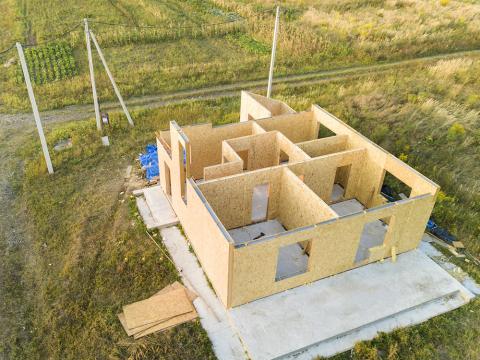In Pro Builder’s March/April issue, I laid out the case for why the “Fourth Wave” of the technology that will change home building forever has finally arrived. And since my presentation at the International Builders’ Show (IBS) in February about how to choose between off-site construction methods versus on-site production methods for your business, and further discussions with colleagues, the supporting evidence for this evolution has grown from three basic factors (need, innovation, and capital) to a list of 10 factors that are accelerating the change—as evidenced by almost daily articles, blogs, or LinkedIn posts about the latest technology enabling the adoption of off-site construction.
Are Off-Site Construction Methods a Real Solution to the Housing Industry's Challenges?
But many builders still consider factory-built construction to be anything but a real solution to labor shortages and cycle-time inflation, believing this latest bandwagon is just another load of publicity and marketing hype. After all, we’ve heard the same claims for decades on end.
Yet, I’m convinced these 10 factors make extensive adoption of off-site manufacturing technologies in home building inevitable—and sooner than later. I’ve broken them into two general, sometimes overlapping, categories—drivers and enablers—below. Think of drivers as the forces pushing home building toward manufactured off-site solutions, while the enablers remove barriers to implementation.
Combined, this is a movement that can’t be stopped or even postponed. The evolution is picking up speed at such a rate it may soon reach the status of a full-fledged revolution.
Factors Driving the Adoption of Off-Site Construction Methods
1. Housing demand
Much has been written about the housing market’s unprecedented surge in home prices and sharp decline in available homes during the COVID-19 pandemic, so I won’t cover that ground again. Even with price increases averaging north of 35% over two years, sales rose while deliveries fell further behind. As I write, interest rates have jumped, as expected, to help curb overall economic (and presumably, housing) inflation. Theoretically, that takes tens of thousands, possibly hundreds of thousands, of potential homebuyers out of the market. Yet historically, interest rates remain low. My take is, after lamenting the loss of an all-time low interest rate, people will get on with the process of buying a home, as long as mortgage rates don’t breach 6%. With an election coming up in 2024, breaking that barrier is unlikely.
Backing up the market, though, is a national housing shortage, estimated to be anywhere from 1 million units (National Association of Home Builders) to 6.8 million (National Association of Realtors). There is no question the demand is there—and this is the critical point—at a price. Affordability has become ever more paramount, and we can’t fully tap this pent-up demand without solving that equation. Off-site manufacturing will be, by necessity, part of the housing affordability solution.
2. Labor shortages
First, some good news: Significant advances are being made to bring more young people and diversity to the construction trades. As a member of the Home Builders Institute’s board of trustees, I’m proud to acknowledge the leadership of HBI president and CEO Ed Brady and his nationwide team for being the nation’s leading educational resource for career technical education in residential construction. HBI’s programs with military bases, prisons, high schools, and its partnerships with other vocational and community college–based efforts are having a huge impact. The bad news is all of this trade training combined still doesn’t meet the needs of today’s building industry; a problem compounded by a rapidly aging workforce. The only way to bridge this gap is by increasing the adoption of manufacturing technologies. And don’t worry, robots won’t be taking anyone’s job; we’re that far in the hole.
3. Material shortages
It’s a given that off-site manufacturing reduces site waste, which means better utilization of materials. Add to that the substantial process cost of extra supplier trips to replace damaged, miscut, misappropriated, misordered, or stolen material from jobsites and you’re talking about significant dollars. When builders compare on-site to off-site methods, rarely do they factor in these costs—but they absolutely should, if they want a fair comparison. A recent LinkedIn post by a housing component manufacturer touting the benefits of off-site was answered by a builder who challenged, “So you’re going to tell me your plants have some kind of magic access to materials that builders don’t?” To which the manufacturer responded, “Yes, actually.”
OK, it’s not really magic, but these manufacturing plants aggregate orders from multiple customers and thus can ensure a steadier, more consistent production flow than the average site builder. That enables them to plan, create projections several months out, buy in greater volume (at lower prices), and buy direct from mills or raw material sources, and even to use the futures market, eliminating intermediary steps and costs.
Off-site manufacturing will be, by necessity, part of the housing affordability solution.
So yes, manufactured solutions can absolutely reduce material shortages for builders. Just don’t call one of these providers—with which you lack any kind of relationship—ask for product, and expect an immediate response with the right component at a lower total cost. One builder I know did exactly that, couldn’t get the product when he wanted, and declared, “See? I told you so!” Remember: You have to build trusted relationships with off-site providers, just as you would (or should) with any supplier.
4. Cycle-time inflation
As I’ve covered repeatedly in this column over the years, few builders understand how to calculate the true total cost of a schedule day—and it’s enormous. (To determine your own, email me at scott@truen.com for a working copy of our “Saved Day Calculator” Excel template.) Home building today averages more than double the construction cycle time on a national basis, compared with 12 years ago, prior to the big crash.
Yes, material and supply shortages make it tougher, yet I know at least five builders in different markets with different product types that have kept their cycle times down to fewer than 100 days. It can be done, and moving to off-site construction of components, foundations, trusses, walls, simple panels, and especially more complex ones, is proven to reduce cycle time.
5. Sustainability
Even though this wasn’t on my original list, a major industry supplier insisted I include it, and he’s right. Manufacturing plants have had to address environmental issues at a higher level and earlier than home builders, but it’s now on your doorsteps and can’t be ignored. The current lumber shortage is front and center, and the sustainability concern is obvious and will make sourcing an even greater challenge.
Today, when builders are asked to cite their greatest shortage, it’s often windows. Most window frames are currently made from polyvinyl chloride, a material derived from salt and crude oil in roughly equal quantities. There are relatively minor environmental impact issues with salt, primarily from over-application on roads and bridges in winter and subsequent runoff into the watershed. But crude oil? Where do we start?
We are about to experience not just interesting but genuinely exciting times as the construction process makes a huge leap forward in efficiency.
Then there’s vinyl siding—also petroleum based—and another major shortage concern. Asphalt shingles have rarely been in short supply, yet their primary ingredient also is oil. As a result, any additional sustainability pressure on petroleum creates even greater need for eliminating waste from those products. And there are myriad other products in our homes with similar sustainability concerns.
Also consider the amount of construction waste on jobsites. Nationwide, we average four dumpster pulls per house, or an equivalent amount by any other method. With further application of off-site manufacturing, we can cut that by at least half, and in the case of modular, by more than 90%.
In summary, sustainability issues are much better addressed in the factory than on the jobsite.
Factors Enabling the Adoption of Off-Site Construction Methods
6. Availability of investment capital
I used to average perhaps one call per year from someone representing private investors seeking information on a building industry company. In the past year, it’s been more like once a month. The evidence at IBS was abundant. Friends and colleagues with new technology, either software applications or manufacturing methods, were approached by interested investors with “briefcases full of money.” These investors look at the inefficiency of home building, gauge both current and backlog demand, and conclude that any viable solution has investment potential. This flurry of funding activity is a dramatic change for our industry. If you have a strong technology application that promises to improve home building efficiency, there’s little doubt you’ll be able to find the financial backing you need.
7. Technology breakthroughs in computer software
Software technology for our industry has steadily improved over the past decade, and the great majority of builders closing 50 units or more have implemented one of the 10 or 12 major brands that cover, at minimum, job cost accounting and project scheduling. What has emerged recently is a greater focus on integrated solutions that can move all of the information needed to build a house from design, to sales, through options, selections, and even customization, over to purchasing, then on to construction. While the focus has been on on-site methods, I know several firms now working on off-site interfaces.
Most software providers tout some degree of integration, yet most builders (their customers) will cite lack of integration as a big hurdle. The processing and storage power is now available to manage all of the interfaces with all of the companies, people, pieces, and parts that come together to build a home, provided the software can handle the millions or even billions of permutations. Most every other industry has reached full integration from sales order through production, and achievements in this arena in home building will further position the adoption of off-site construction methods as a solution.
Off-site building technology can play a major role in eliminating all forms of waste in home building.
Of course, none of this will work until builders fully commit to keeping the databases up to date—every plan, every bill of materials, every specification, every schedule for every house—every day. (We’ll talk about this problem—why your software isn’t working—more in a future column.)
8. Technology breakthroughs in off-site manufacturing methods
Surprise! I’m not going to talk about 3D printed homes, which I believe are overhyped for more than 90% of housing applications, at least in this country. Instead, let’s talk about off-site manufacturing that largely duplicates what we do on site but in far more efficient ways.
Over the next few years, you’ll see manufacturing processes come online that make an enormous difference in two ways. One is the production of new materials that will contribute significantly to solving some of our most critical shortages. The other is the far more efficient construction of the components themselves, and not just trusses and panels.
One firm, for example, is using robotics to assemble walls and panels at an entirely new level. I personally know of five or six of these companies, some established, some startups, and for each one I know of there are probably 10 others. Indeed, we are about to experience not just interesting but genuinely exciting times as the construction process makes a huge leap forward in efficiency. Establish those relationships now because demand will definitely exceed supply.
9. Learning-curve acceleration
IBS was shut down in 2021, but in 2020 you could count on one hand the number of education sessions addressing new technologies in housing. This year there were at least 15 in the official education program, with many more tech-centered discussions at exhibit booths and in private meetings. You’ll find the same phenomenon with webinars and videos on new technologies offered by various consultants and companies, such as the monthly Housing Innovation Alliance meetup and Dave Cooper’s LinkedIn presentations, among many others.
A whole new world is opening up to those who want to learn about and apply new technology in construction. You’ll no longer feel like a lonely voice in the crowd. Sure, you’re still in the minority, but with the remarkable acceleration of the learning curve for technology applications, you won’t be for long.
10. New methods for making “true total cost” comparisons
I’ve published several columns on this subject, but here’s the synopsis. As I once said in a presentation at a conference of housing industry CFOs, using intentionally bad grammar, “You guys don’t count so good!” Whether it is process measures reporting in near real time, or results measures looking in the rearview mirror, we often measure the wrong things, measure the right things incorrectly, or fail to measure at all.
Whenever I’ve worked with builders comparing on-site to off-site production costs, it’s been difficult to push them past surface-level bid price to a deeper evaluation of true total cost, including critical factors of quality, delivery, warranty, and cycle time, among others. Without that, you simply cannot make the best decisions.
I have been teasing a reveal of our newest template for “On-site vs. Off-site” true total cost comparisons for over a year now. This template will make it far easier to justify greater adoption of off-site methods—or not—based on data. The challenge has been keeping the template from becoming overly complex. We’re nearly there, so if you’d like to be part of a beta test for the new calculator, drop me a line at scott@truen.com.
The Answer to the Housing Affordability Crisis
Each day brings another scary article or post about housing’s affordability crisis. We either solve that or watch our industry recede. With interest rates climbing, the only answer to affordability is cost reduction. And with increasing labor and material shortages, the solution for reducing costs is efficiency. The only serious route to efficiency, without stripping homes of value, is Lean methodology to eliminate waste in product and process. Applying off-site building technology can play a major role in eliminating waste in all forms, not just on the jobsite but in every phase of the business. The time has come. There is no turning back.






